
We are celebrating 15 years — and counting — of stories that are deeply researched and deeply felt, that build a historical record of what the city has been.
We are celebrating 15 years — and counting — of stories that are deeply researched and deeply felt, that build a historical record of what the city has been.
23-29 Washington Place, constructed in 1900, is currently known as NYU’s Brown Building. But it was originally known as the Asch Building, the site of the Shirtwaist-makerʼs Strike of 1909 and the Triangle Shirtwaist Factory fire of 1911. In 2003, the New York City Landmarks Preservation Commission conferred landmark status on the building, deeming it to have “a special character and a special historical and aesthetic interest and value as part of the development, heritage, and cultural characteristics of New York City.” It has been a National Historic Landmark since 1991, and its citation reads that the building “stands as a reminder of both the triumph and the tragedy of the labor movement in early twentieth century America.”
The centennial of this tragedy led to the creation of the Triangle Fire Open Archive and Open Museum, a pair of projects that commemorates this place and its history, and bridges the multiple communities with stakes – both personal and political – in the site and the fire by encouraging their ongoing participation. The design and production of these projects is the work of Buscada, an interdisciplinary creative practice that focuses on place and dialogue, co-founded by Gabrielle Bendiner-Viani, an environmental psychologist and photographer, and Kaushik Panchal, a designer. Buscada creates projects that engender conversations between communities, individuals and disciplines to explore critical questions of cities and visual urbanism. Below, Bendiner-Viani discusses how Buscada went about creating the Open Archive and Open Museum, reflecting on the Triangle Fire’s enduring significance to legal histories of labor and immigrant rights, architectural histories of fire safety and building codes, and familial histories of tragic loss and political awakening. Working closely with the constituents of the Remember the Triangle Fire Coalition, Buscada took the diversity of stakeholders’ perspectives on this event as a point of departure for an open and participatory process of commemoration, drawing on the full range of emotional associations with the tragedy: personal, familial, ethnic, socio-economic, and civic. Therefore, the Open Archive and Open Museum present valuable case studies in ongoing debates about the politics of memory, strategies of memorialization, and collaborative practices for informing our present with an understanding of our past. –C. S.
The Triangle Fire and Its Legacy
In the early 1900s, “the garment industry was the largest employer in New York City, with the shirtwaist, a high-necked blouse, its most popular product.” The Triangle Waist Company was a major producer of these essential garments for the fashionable woman. While many garment factories at the time were still sweatshops in tenement apartments, the Triangle was comparatively modern, in a new ten-story, steel-frame, loft building one block east of Washington Square Park. Nonetheless, the working conditions at Triangle and many other new garment factories were horrible, and fire hazards were numerous. Union busting was common at the time, and these conditions led to a powerful statement by the workers: a 13-week general strike of 20,000 shirtwaist-makers, almost all young women, led by the charismatic young seamstress Clara Lemlich. This ”Uprising of 20,000” was a highly visible protest by an unlikely body of workers on the streets of New York and other cities.
Just two years later, on Saturday March 25, 1911, a terrible fire broke out at the Triangle Shirtwaist Factory, on the eighth floor of the Asch Building. On the ninth floor, a critical exit was locked, and fire truck ladders of the day could only reach the sixth floor. As the fire spread, workers piled into the elevator; in desperation, some women tumbled down the shaft. The fire escape collapsed, and passersby watched in horror as workers with no other way out jumped from the windows to their deaths. Most of the 146 people killed by the fire were young, recently-arrived immigrant women. Many of those watching on the street remembered seeing similar young women protesting their working conditions in the streets less than two years before. At the later trial, the owners, long known for their anti-union activities, were acquitted of manslaughter.
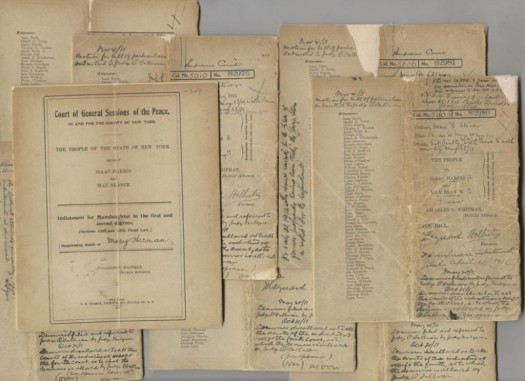
Court Records from the trial of Blanck and Harris. Click image to view the related entry in the Triangle Fire Open Archive.
News of this public tragedy was widespread, and it galvanized a powerful movement for social justice, specifically for the rights of workers, women and immigrants. Many of our current labor and fire protection laws were created in response to this event, from sidewalk dimensions to sprinkler regulations to the stipulated number of exits and fire escapes. And its political influence extended beyond fire safety: Frances Perkins, who would later become FDR’s Secretary of Labor and the first woman in the Cabinet, witnessed the fire and later described it as “the day the New Deal began.”
101 years later, although the event is no longer in anyoneʼs living memory, many people still remember the victims and the survivors, as well as the countless others touched by the tragedy: politicians, lawyers, union organizers, even the elevator operator who helped people escape.
Even those of us without a direct connection to the event live within the wake of its impact. Labor reforms, the rise of feminist and suffrage movements, and the development of powerful safety regulations are all deeply relevant to working conditions today — both in the United States and abroad. This became strikingly clear in December 2010, when an equally horrific factory fire in Dhaka, Bangladesh trapped a mostly-female work staff, causing many to jump from the ninth and tenth floors, just as the women on the corner of Washington Square Park had done, thousands of miles away and 100 years before.
Clearly, the stories and issues related to the Triangle Fire are too important to consign to a fixed past; their import and impact are still so close at hand. Therefore, when my organization, Buscada, began working with the Remember the Triangle Fire Coalition to explore the fire’s personal and political significance, the first step was to consider how the meanings and implications of this historical event could be gathered and presented as active and evolving in the present day. Finding a way to do so is all the more critical at a time when politicians frame unions as the enemy, union membership continues to fall precipitously, and complex tragedies with contested meanings occur too frequently to memorialize meaningfully, or even to make sense of them.
Creating the Triangle Fire Open Archive
The Remember the Triangle Fire Coalition, founded by filmmaker Ruth Sergel, is a diverse, volunteer-run, grassroots organization that came together in 2009 to begin planning for the tragedy’s centennial anniversary. Its mission is to “spearhead the creation of commemorative events – activism, education, art…. to build the muscles of active social engagement.” Comprised of an extraordinary range of constituents — labor organizers, feminist activists, university faculty and students, family members of fire victims, artists, and safety engineers — each Coalition member interprets the Triangle Fire with a distinct perspective.
The Coalition originally approached Buscada in 2010 to create a repository for the family photos and mementos related to the fire that people were beginning to post on the Coalition’s Facebook page. These images revealed a diversity and specificity of memories that was too interesting to confine to the black hole of Facebook’s timeline. What we created turned out to be much closer to a memorial than any of us suspected at the time, as we developed a project that learned from, and sought to honor, those initial contributions.
As a born-and-bred New Yorker, I knew about the Triangle Fire, but I had not understood the depth of its impact on the city, or its connection to those still living, until I began to talk with the wide range of people at the Coalition’s meetings, and to look at some of these individually-contributed images that told fragments of Triangle’s story.
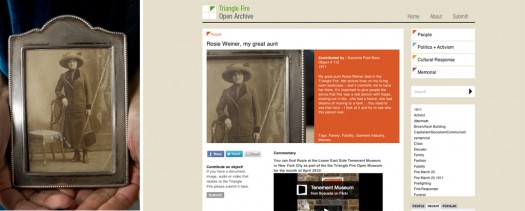
Left: A family photograph of Rosie Weiner, who perished in the fire, in the hands of her great-niece | Right: Rosie Weiner’s entry in the Open Archive
We created the Open Archive as an ongoing participatory online archive to understand the Triangle Fire not only through historical narrative but also through contemporary human connection, inspired by the variety of perspectives represented by the Coalition. To tell the story, we sought out “objects” (rather than oral histories or images alone) for their power both to ground us in the present and to form links across lifetimes. The “thing-ness” of these objects helps to make the unfathomable concrete, and their juxtaposition illuminates surprising connections between discrete artifacts. We began with the images posted on Facebook (which were usually scans of photographic “objects”), and then put out a much broader call to anyone touched by the fire or its legacy, inviting submissions of documents, keepsakes, images, video, audio, even building materials. We refer to these materials as Open Archive “objects.” Each entry in the Open Archive consists of photographs (of an object) or other media accompanied by a short statement by the person who submitted it, explaining how he or she perceives the object’s significance. Therefore, the dialogue that the Open Archive fosters is comprised, literally, of voices from within affected communities, including labor, Jewish, Italian-American, women, immigrant, fire and safety professional, and garment worker communities. We also attend meetings and events, inviting people to bring the objects they’d like to contribute. We interview them, and we photograph their objects, often held in their contributors’ hands. People can also photograph or scan objects themselves and submit them online. Once part of the Open Archive, each item lives in its original context – on a shelf at home, perhaps – as well as in a new and public environment online.
The Open Archive currently consists of more than 200 objects, ranging from a framed photograph of a victim, Rosie Weiner, contributed by her great niece, to a series of embroidered armbands made by a performance artist, to the Occupational Safety and Health Administration (OSHA) legislation contributed by a union Health and Safety director, to memorabilia from the historic 1982 garment workers strike in Manhattan’s Chinatown.
Each of these objects – seemingly unassuming as individual items – reflects the fire’s influence in our contemporary world and contributes to the cumulative meaning of the tragedy. Therefore, no single person or object is responsible for all perspectives on this multivalent event. Rather, the power of communal testimony resists any overarching or monumental narrative in favor of a collective and ongoing conversation rooted in “everyday” objects like family photographs, hand-made memorials, sprinkler heads, Memorial Mass invitations, building inspection reports, or letters, among many others. Given the diversity of the material, juxtaposing an old family photograph with a placard from recent protests over Wisconsin’s union busting makes visible the complex communities of difference that surround issues of labor, women’s rights, and immigrants’ rights. In this way, the collection as a whole contextualizes each individual contribution.
Inventing an Open Museum
This spring, we created the Triangle Fire Open Museum to embody the Open Archive physically, making its virtual objects tangible again. To exhibit objects from the Archive, we borrow them temporarily from their owners, or create photographic stand-ins, and we display them in self-contained exhibition cases we designed for the project. They are not collected in a gallery, but rather are shown in locations across the city that connect thematically to issues of immigrant, women’s and labor rights. In the first phase of the Open Museum, institutions around the city, including the Lower East Side Tenement Museum, the Museum of Chinese in America (MoCA), the New York City Fire Museum, Fashion Institute of Technology, and CUNY’s Murphy Institute for Worker Education, adopted objects for a two-month period.
Therefore, visitors to the dispersed, embodied and temporal Open Museum traverse not only exhibition spaces, but the city itself. Visitors can pick up an Open Museum guidebook and map at any of the sites, and can take a self-guided tour to find the other objects, accessing new places, and seeing our city’s past and present in a new way. The juxtaposition of public and private spaces with the Open Archive objects casts each in a new light of the social justice legacy of the Triangle Fire.
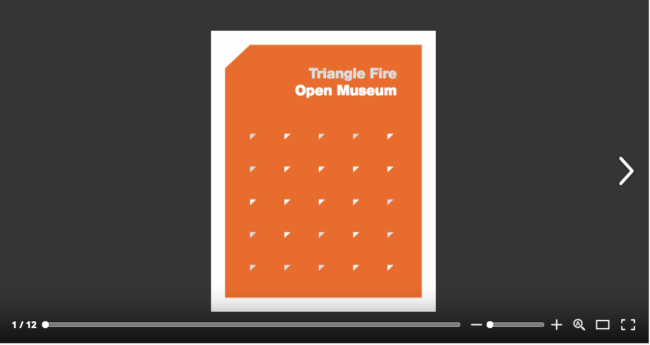
This winter, we are planning to work with another group of New York institutions to create a new guided tour of Open Museum sites, and are currently welcoming new host institutions who might want to adopt an object. The issues at the heart of the Triangle Fire are still just as timely and critical as they ever were, and the Open Archive and Open Museum challenge participants to find objects that contribute to a layered Triangle narrative, as seen from where they stand.
Ephemeral and Multiple
While the Open Archive and the Open Museum benefit from their dispersed nature, the Remember the Triangle Fire Coalition is also sponsoring a design competition for a memorial at the site of the Asch / Brown Building. As such, these projects take part in the larger memorialization dialogue about permanence and ephemerality in the urban fabric.
Two other recent memorial projects call to mind the tension between sited permanence and ephemeral multiplicity. Two AIDS memorials walk this line: the Names Project’s inherently multi-pieced AIDS Quilt and the newly approved AIDS Memorial in New York’s West Village, the design of which was the subject of intense debate and counter-proposals. And of course, the Tribute in Light, a memorial that was ephemeral and visible from across the city, is quite different from the permanent 9/11 Memorial now open downtown, which requires a pre-booked visitor’s pass.
“Permanent” memorials can be experienced in the same place at any time, thus linking the meanings of an event to a particular site and enabling pilgrimage for generations to come. Yet, the complex challenges that new memorials face often stem from their very permanence: different stakeholders fight for the right to tell the story their way, and the costly and contentious nature of real estate (especially in New York) always constrains what can be built.
The ephemeral and the multiple suggest that memorials and museums can be more than sites of pilgrimage. Rather, they can be experiences integrated into daily life. Dispersed or ephemeral memorials can create opportunities for reflection within the flow of other activities, opportunities to see the past in the present day, and to consider the extent to which past and present are interlinked.
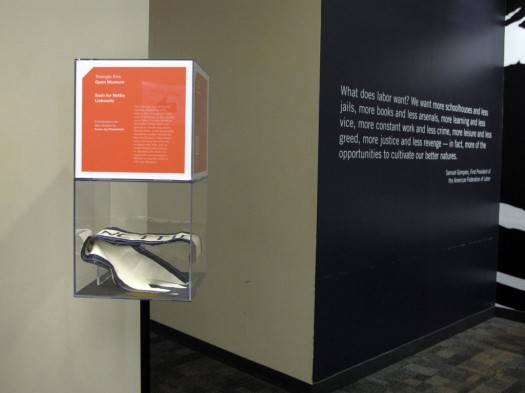
An object from the archive, a sash for Nettie Liebowitz, installed at the Murphy Institute, CUNY | Click image to visit the related Open Archive entry
Unless otherwise noted, all images appear courtesy of the author.
The views expressed here are those of the authors only and do not reflect the position of The Architectural League of New York.
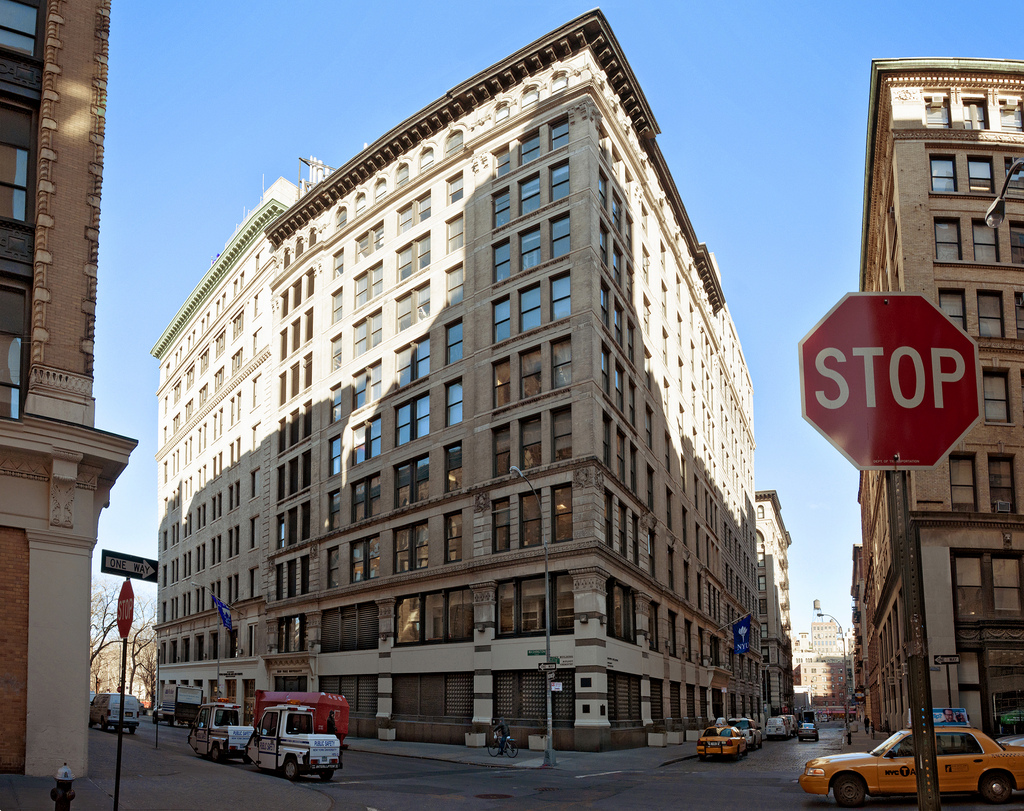
Comments